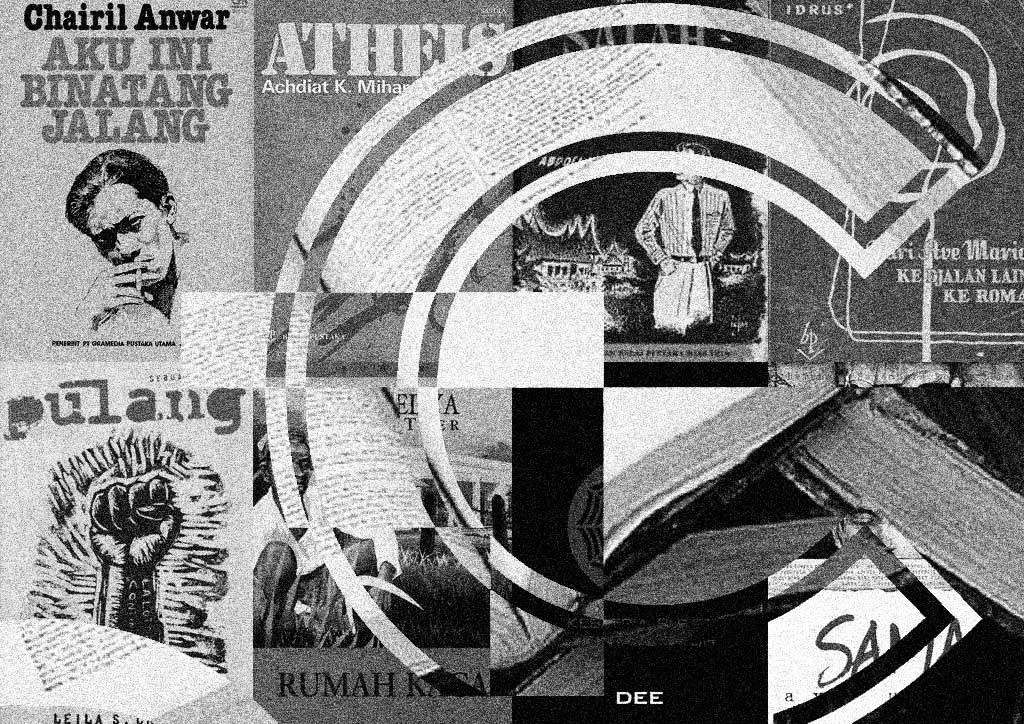Translating Indonesian Literature
Promoting Culture, Spreading Ideas, Fostering Change.

Column written by: Dirgantara Reksa
“…without a love of literature, you’ll remain just a lot of clever animals.”
—Pramoedya Ananta Toer, Bumi Manusia
In April of 2014, Indonesia’s vice minister for education and culture, Wiendu Nuryanti, announced that the Indonesian government would allocate 11 billion rupiah for the translation of 150 chosen Indonesian works of literature, from Bahasa Indonesia into English and German, to be presented at the Frankfurt Book Fair in Frankfurt, Germany, October 2015. (1) The government initiative has the potential to bring good news for the Indonesian people and to the world as a whole, as it heralds the inclusion of Indonesian literature into the international literary community, giving the world a chance to enjoy Indonesian literature. (2)
Although Indonesian literature is not commonly available in the international market, it has long received international acknowledgement and consideration. To give examples, since 1979, more than 30 Indonesian writers have become nominees in the annual Southeast Asian Writers Award; since 1967, more than 35 Indonesian writers have participated in the International Writing Program in Iowa; in 2011, Khairani Barokka became the first Indonesian writer-in-residence at the Vermont Studio Center in 2011; and of course, Indonesia’s Pramoedya Ananta Toer has been nominated several times for the Nobel Prize for Literature. (3)
The act of translating is not merely the process of converting one language into another—it is the process of exposing ideas, cultures, history and interpretation, for the benefit of all mankind. Indonesia should not only be notorious for its corruption, human rights issues, and environmental destruction, but respected and understood—domestically and internationally—for its writers, literature, and culture. Translating Indonesian literature is a process that finds itself within an ever-pressing sense of (global) urgency. The ASEAN Economic Community, scheduled for implementation in 2015, brings with it competition alongside opportunity, diffusion alongside integration, giving efforts of translating Indonesian works a new economic imperative. All that considered, Indonesia’s literature not only has the right to be translated; it deserves to be translated, so that not only can Indonesian literature secure a place for itself within the ASEAN market, but so that it can complement and even outshine other foreign works of literature, as a contribution to humanity.
Currently, the global map of world literature is no longer dominated by eurocentrism and a subconscious affinity for anything ‘Western. In the past decade, in the United Kingdom and the United States, more and more works of literature are coming from writers belonging to immigrant backgrounds, from territories once ruled by colonial powers (such as Asia, Africa, and Latin America). (4)
Literature and Historical Experiences
Literature is not simply aesthetic or symbolic; in any time and place, it is part of a collective historical narrative that bears witness to the many social and political experiences and transformations of mankind, to be seen and read not as a relic, but as a reflection for the future. Ajip Rosidi said that cultural consciousness is what becomes the marker of Indonesian literature. This cultural consciousness is in fact a matter of politics; the many problems faced by Indonesian literature is inseperable from political problems faced by the people as a whole. (5)
Nyoman Kutha Ratna (2008) in her book, Postkolonialisme Indonesia: Relevansi Sastra, examines thirteen novels that provide a track record of colonialism in Indonesia. (6) These books describe in detail the impact of colonialization on the Indonesian people, as well as the collective social and political zeitgeist of the time: a struggle to define and come to terms with their ‘national identity,’ as well as to answer the question of the nation’s future after their independence.
Contemporary Indonesian literature does not fall short of its historical ancestors, for the crises of nature and people, the ebbs and flows of struggle and conflict, is as overwhelmingly important now than as it was before. Books such as Saman (Ayu Utami, 1998) and Larung (Ayu Utami, 2001) explain the social conditions in Indonesia approaching reformasi; Supernova (Dewi Lestari, 2001) also sketches the lives of the urban population in Indonesia today.
Challenges in Practice
The biggest challenge and obstacle in the translation of Indonesian literature lies within the cultural habits of the Indonesian people itself. Before a work of literature is translated into a foreign language, ideally, that work should be read and respected beforehand in its village of origin. Unfortunately, that is not the case in Indonesia—many Indonesian people are not aware of their own literary stock and heritage. One of the factors contributing to this lack of literary appreciation is the oral (as opposed to written) culture so dominantly prevalent in Indonesian societies, as a form of cultural transference from one generation to the next (Ong: 1982).
Another challenge is the difficulty of accessing and marketing Indonesian works of literature in common bookstores throughout the country. Readers have to look high and low in used bookstores to be able to access Indonesian books of literature. This stems from the book industry’s credo of accumulation and expansion, which gives books a place in the market only if they can reach or exceed a specified sale target. Fortunately, many young Indonesians are resisting the system and opening their own alternative bookstores and reading spots that provide cultural and literary works in a conducive and enjoyable environment. (7)
The next challenge is the human resources required. Not many translators can accurately and eloquently translate Indonesian literary works, for what is being translated is not merely the language itself, but sets of words and sentences which hold meaning. To elaborate meaning, the process of translating needs to examine not only language, but also the many cultural aspects which the language embodies. (8)
Last but not least is the competition faced by Indonesian literary works in international markets. As a new kid on the block, Indonesia will have to face many older and bigger players (English and American publishers). However, what Indonesians have on their side is their vast and immense cultural and social well, spanning millennia of history and taking place within more than 17.000 islands—a continuously evolving interpretation of culture and society, shaped not only by historical forces set in stone, but also by the ever-shifting dynamics of power, of hegemony and domination of people through the many apparatuses of the state, from wayang to television, from Majapahit to the modern republic. All this is, without a doubt, first-class literary material.
The Inheritance of Hope
The translation of Indonesian literature is not an optional convenience, but a moral obligation. The more works of literature that are translated, the better the opportunity for these works to be appreciated by a greater audience; this in turn will lead to a rise in the growth of Indonesian literature and its writers. The success and failure of this task lies with the effective cooperation of the government, writers, readers, and publishers, to collaborate and hold firm a single vision for the future: to protect and nurture Indonesia’s literature in order to secure the richness of the past, for the sake of the brightness of the future, for ultimately, a great nation is one that values and respects its literature and its writers.
Notes on the third page.
Notes
(1) Bambang Sutopo Hadi, “Rp 11 Miliar Untuk Penerjemahan Sastra”, Antara News, 23 April 2014 21:05. Accessed from http://www.antaranews.com/berita/430836/rp11-miliar-untuk-penerjemahan-sastra/
(2) The ministry for education and culture formed a committee for books and translation for the Frankfurt Book Fair, which consists of several large publishers such as Yayasan Lontar, Balai Pustaka, and Gramedia. As a guest of honor, Indonesia will introduce its literary works in the form of 800 translated works in English or German, alongside 100 Indonesian writers. For this, the committee financed around 200 books of literature to be translated, both classical and contemporary, such as Aku (Chairil Anwar, 1943), Atheis (Achdiat K. Mihardja, 1949), Sitti Nurbaya (Mh. Rusli, 1922), Salah Asuhan (Abdoel Moeis, 1928), Dari Ave Maria ke Jalan Lain ke Roma (Idrus, 1948), Keberangkatan (Nh. Dini, 1977), Supernova (Dewi Lestari, 2001), Pulang (Leila S. Chudori, 2012), and Saman (Ayu Utami, 1998). See http://badanbahasa.kemdikbud.go.id/lamanbahasa/
(3) Pramoedya Ananta Toer has had his books published internationally in English through Penguin Books since 1980. These include Tetralogi Pulau Buru (Buru Quartet), Nyanyi Sunyi Seorang Bisu (The Mute’s Soliloquy), Cerita Dari Blora (All That Is Gone), Perburuan (The Fugitive), and Bukan Pasar Malam (It’s Not an All Night Fair).
(4) These writers include Salman Rushdie, Ben Okrie, Zadie Smith, and Li-Young Lee (born in Jakarta). In 2006, the Nobel Prize for Literature was given to Orhan Pamuk, a writer from Turkey—a country that beforehand was not given much attention by the international literary community—who wrote in his mother tongue. In 2012, the same prize was given to Mo Yan, a Chinese writer who wrote Red Shorgum, a book about the experiences of three generations of a Chinese family from 1923 until 1976.
(5) Bahasa dan Kebudayaan Nasional, ”Pikiran Rakyat”, 3 Juli 2010
(6) These books are Cerita Nyai Dasima (G. Francis, 1896), Cerita Nyai Paina (H. Kommer, 1900), Max Havelar (Multatuli, 1860), Manusia Bebas (Suwarsih Djojopuspita, 1940), Sitti Nurbaya (Marah Rusli, 1922), Salah Asuhan (Abdoel Moeis, 1928), Layar Terkembang (Sutan Takdir Alisyahbana, 1937), Belenggu (Armijn Pane, 1940), Atheis (Achdiat Kartamihardja, 1949), Pulang (Toha Mohtar, 1958), Bumi Manusia (Pramoedya Ananta Toer, 1981), Burung-Burung Manyar (Y.B. Mangunwijaya, 1981), and Para Priyayi (Umar Kayam, 1992).
(7) Examples include Toko Buku Kecil and Malka in Bandung, Freedom Institute in Jakarta, and Resist Book in Yogyakarta.
(8) Quoting Bassnett (2002:21): “Beyond the notion stressed by narrowly linguistic approach, that translation involves the transfer of “meaning” contained in one set of language sign into another set of language sign through competent use of the dictionary and grammar, the process involves a whole set of extra-linguistic criteria also.” To give a practical example, Yayasan Lontar (an institute based in Jakarta since 1987 that promotes Indonesian literature and culture through the translation of Indonesian works of literature) has translators that are not only are fluent in foreign languages but also in local languages as well, such as Javanese, Sundanese, and Chinese (for the translation of Indonesian-Chinese writings). These translators are required to have an understand of the social and cultural underlyings in a particular work, so that the output of translation is not merely a transfer of text but also of context.











